Author Interview
“Take only what you need, no more, no less.” (Sharing)
Sharing (Magabala Books) is the third book in the profound and contemplative Our Place series for young children. It is written by Aunty Fay Muir and Sue Lawson and illustrated by Leanne Mulgo Watson.
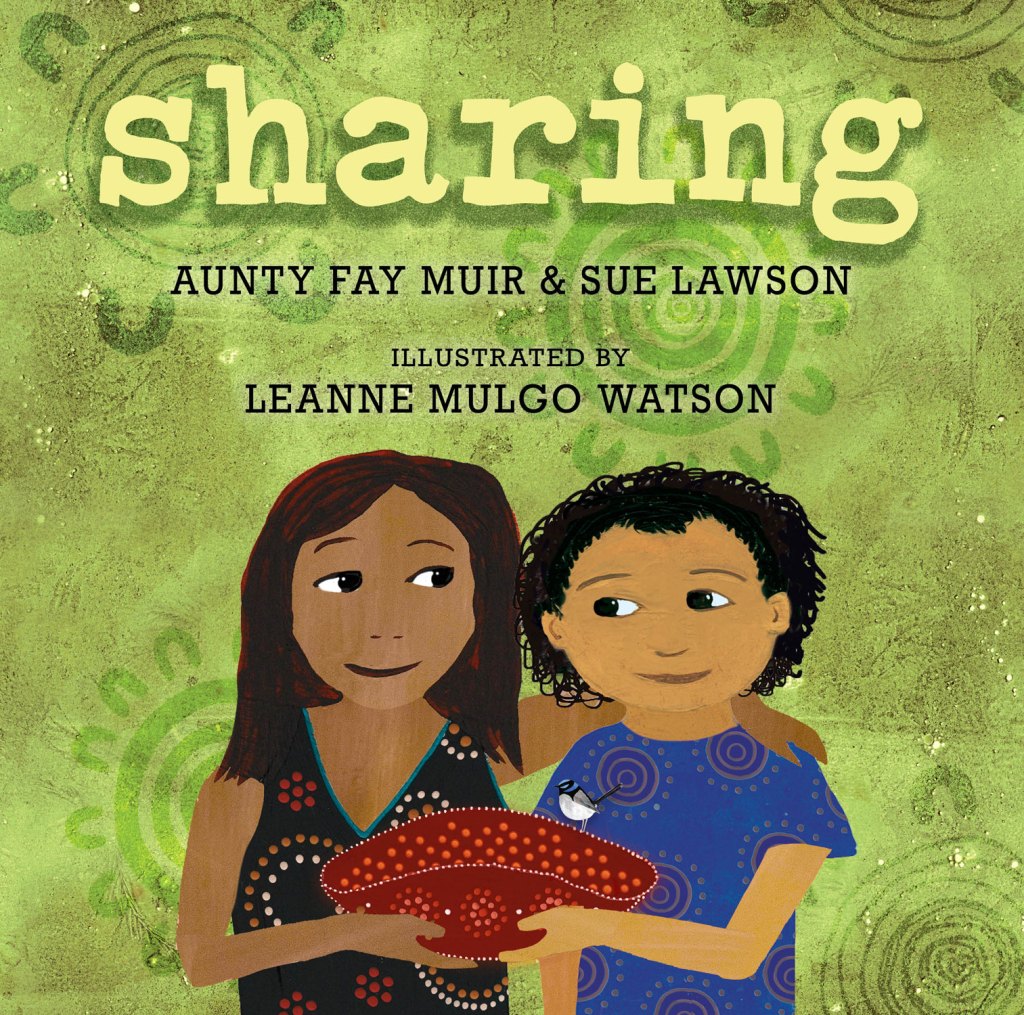
Thank you for speaking to PaperbarkWords, Aunty Fay and Sue. Could you please introduce your series Our Place?
Sue
Joy, thank you so much for inviting us both to Paperbark Words.
Fay is the best one to introduce the series, but from my point of view, Our Place is a series that introduces First Nations philosophies to all children. Each book covers a concept that forms the foundation of Aboriginal culture and life.
We want the series to spark conversations and to inspire readers to learn more.
Fay
Hi Joy, thanks for inviting us to be part of Paperwork Words. Our stories are a first introduction for young children to the history of Australia’s First Nations culture and its peoples. Our words might be sparse but they pack a punch in sharing the knowledge of our Elders with our readers. We want the reader to embrace the beautiful illustrations that complement our stories so that it sparks conversation by whoever reads our books to the children.
Is it called Our Place in homage to Sally Morgan’s autobiography My Place or for another reason?
Sue
Just a fluke really, though both are about place and home.
Our series is called Our Place to represent the importance of sharing knowledge and building relationships to truly make Australia a united place, our place. A place where Aboriginal and non-Aboriginal people walk together.
Fay
No, it’s a coincidence really. Our Place series is an early introduction for young children to start them on their journey of learning about First Nations culture and its peoples. It’s also to share with their parents, so that they can also go on that journey together to learn about our First Peoples culture and history.
Each book in the series is illustrated by a different artist. Why is this?
Sue
When Aunty Fay and I first spoke about writing together, we discussed the importance of broadening the representation of Aboriginal Nations in children’s literature. We wanted to see possum skin cloaks and lush bushland, not just red dirt. For too long Aboriginal people have been represented as desert dwellers. We wanted each artist to represent their Country and to show readers the diversity of Australia’s First Nations People. We’ve been thrilled with the illustrations and can’t wait to see the next books in the series.
Fay
In our discussions around illustrations and the artists, we wanted artists from different parts of Australia to represent where they live and the country around them, so that children can see the diversity of our country which is important for children to look outside their own bubble.
Each of our illustrators come from different parts of Australia and this is evident in their individual illustrations. It’s important for children to see the diversity of the Australian countryside.
Could you select an illustration from each of the three books that particularly resonates and tell us why?
Sue
That’s a really tough question as I love all the illustrations.
If I had to choose one from Respect, I’d choose the spread with includes Elders around the campfire. I love the sharing of stories and culture in this way. This illustration is also a favourite as it features Aunty Fay playing possum skin drums.
[Aunty Fay has also chosen this image – see it below]
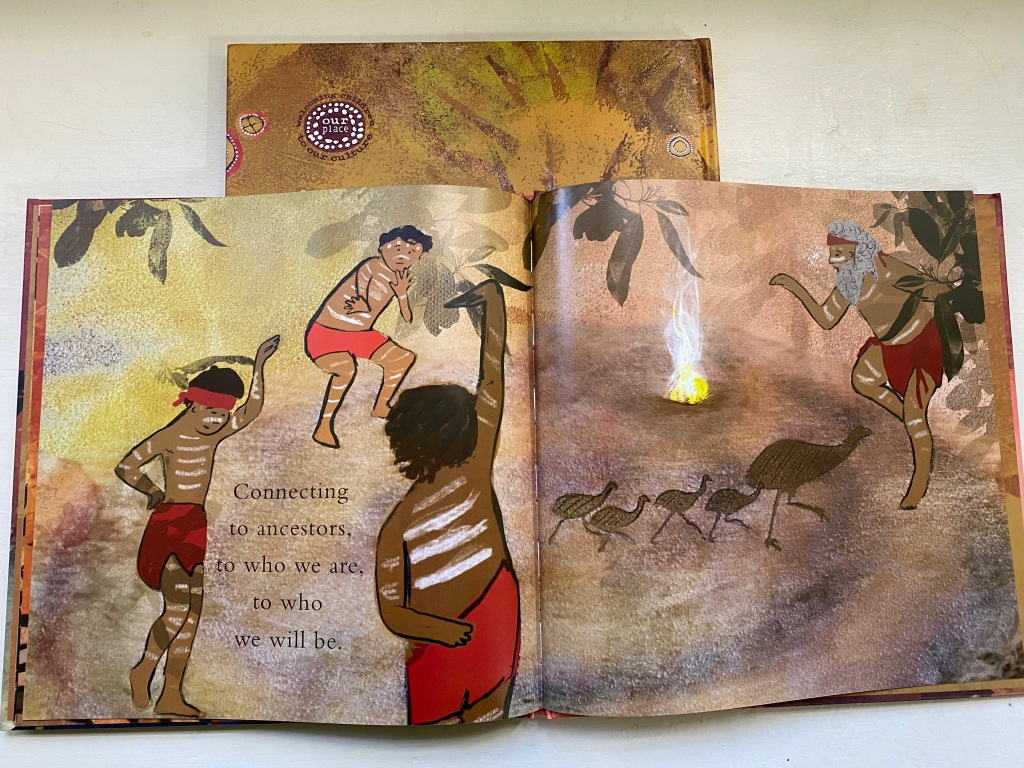
In Family I love the boys dancing, learning about their ancestors, who they are now and who they will become. I love that connection across generations and sharing of knowledge.
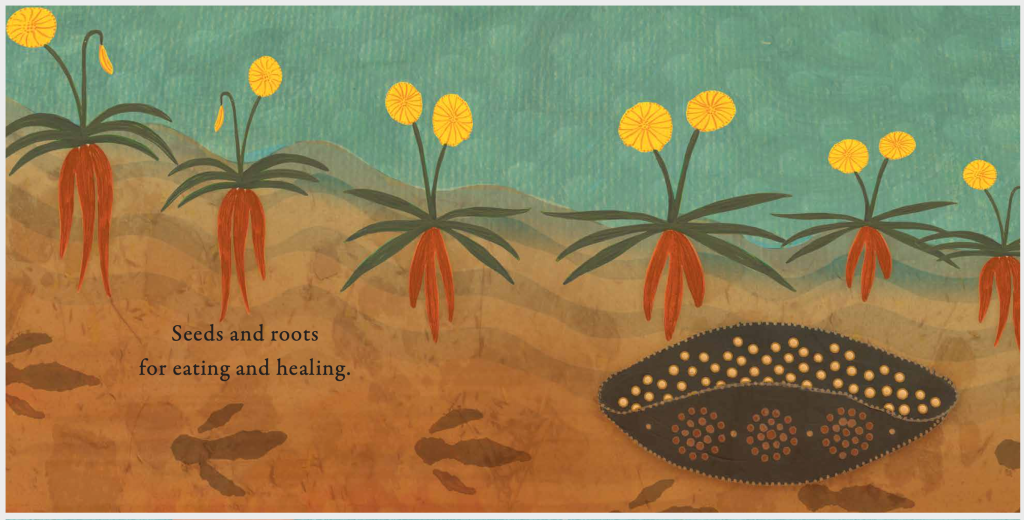
For Sharing, I think it’s the murrnong daisies with emu prints. The colours are amazing, and I love how it leads to the following page.
Fay
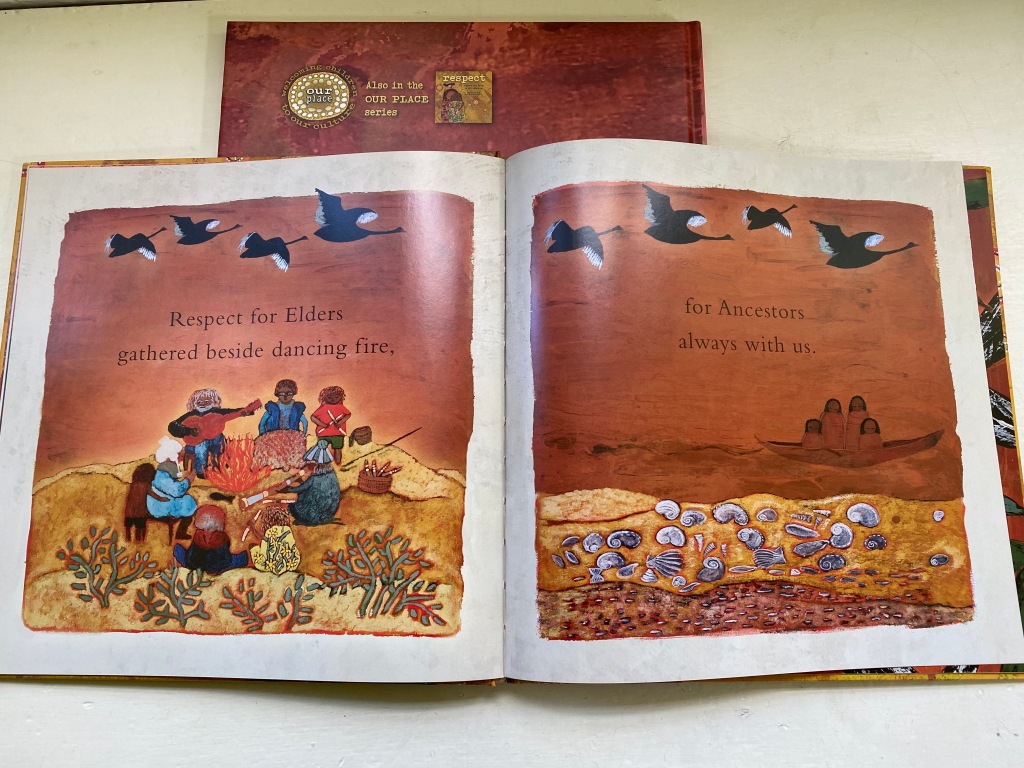
Respect – the illustrations show an extended family sitting around the camp fire, playing musical instruments, sharing stories and passing on knowledge by Elders about culture and country to the children, through music and storytelling. It’s also important to me as it represents myself as an Elder sharing my knowledge about the possum skin drum I have over my knee and also pass on my knowledge about what possum skins were used for by our people, with using the entire animal. It’s about deep listening for children to learn from their Elders and hear how the other instruments were made and from what material they were made from. The illustrations in Respect showcase the connection First Nations People have to country and the flora and animals and birds that live on country and the respect we need to all look after country for our future generations.
Family – the illustration of “connecting to Ancestors” shows an Elder sharing his knowledge about the use of ochre and the story of the ochre painting on the children’s bodies. Teaching the Emu dance to the younger generation and the story behind the dance that was passed onto him from his Elders and explaining to children that our ancestors are always watching to see our young ones taking on that responsibility to share with others.
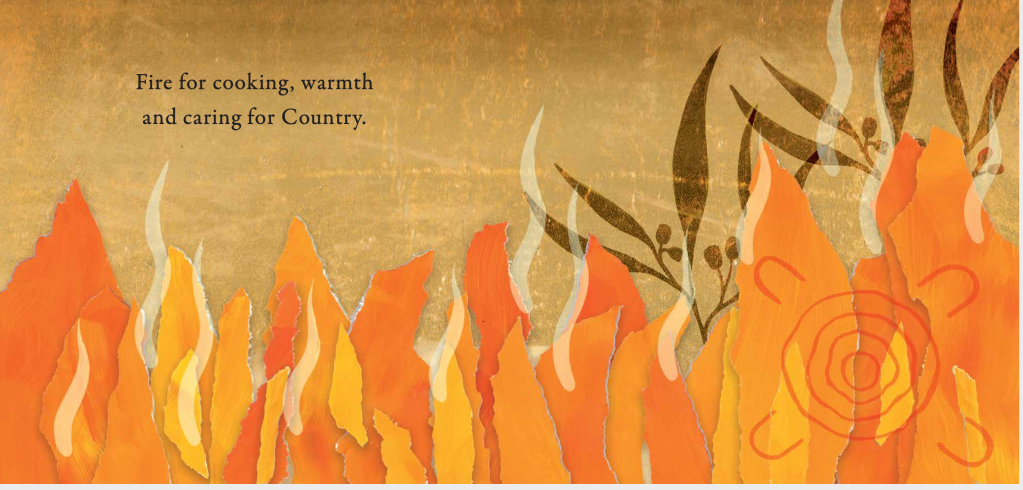
Sharing – the illustration about fire and its importance for caring for country, clearing the undergrowth to stop fire from destroying the forest and animals that live there. For cooking of food to feed the family. This is how we share and care for country and each other. Fire is a tool for caring for country and the regeneration of the seeds for the next seasons harvest.
How does the collaboration between the two of you work? And also with Leanne Mulgo Watson in Sharing?
Sue
Aunty Fay and I meet up to share lunch, talk and laugh. We do work, too! Our books start as a conversation. When we have the topic, I ask Fay questions. Fay shares her vast knowledge and I listen and take notes. Fay has taught and continues to teach me so much. We then draft the story and repeat, over and over until we are happy we have it right. Then it’s time to send it to our editor, Maryann Ballantyne. I love that each book comes from Fay’s deep knowledge and our friendship and conversation.
Once Maryann has the text, she and designer, Donna Rawlins work with the illustrator, and in this case, the incredible Leanne Mulgo Watson. Donna and Maryann show us progress images, but ultimately, we leave the illustrations to Leanne, the expert. We may see cover choices or be asked for comments on a certain image, but the illustrations are all Leanne’s doing.
Fay
We bounce ideas off each other over many cups of tea and a lot of laughter before we come to a final draft. Our ideas are thrown around between us many times and I share my knowledge with Sue. We discuss, write, discuss and write again, put in, take out bits we are not satisfied with until we are happy with the end result.
We then send to our editor for her to look over and she and the designer get together to discuss a suitable illustrator, this being Leanne Mulgo Watson, we leave the illustrations up to her, as she is the one to capture our words into her beautiful designs. We see the images that our editor sends to us but we leave the illustrations to Leanne.
In Sharing, how did you decide what to include, for example water, oche and seeds and roots, and what to leave out? I imagine this took much thought and discussion.
Sue
I think Sharing took several lunch conversations to decide what to leave in and what to take out. Luckily we had written Respect and Family, so we knew it had to be a sparse style of writing. That helps with what to include and what to leave out. Also, the illustrations tell half the story and are able to include what we didn’t in words.
It really is lots of trial and error, tweaking and revisiting. And many emails back and forth.
Fay
Again Sharing was created over many lunch conversations to come up with what to leave in and what to take out. I think in writing the other two books we followed the writing style of both Respect and Family and knew how to write this one. The illustrations in Sharing again embellish the story along with our words
Throughout our discussions our words are describing what’s important to First Nations People who have lived thousands of years caring for this country and living a sustainable life, therefore taking from Mother earth what is required to live and share with family but also to remember to leave some for the next person.
The language in Sharing could be described as simple poetry and seems to emulate someone speaking. Who is speaking and how did you refine the writing to get to this perfect synergy of simplicity and timeless wisdom?
Sue
Fay will speak with authority on this, but for me, Aboriginal language is to the point and has such a musical sound. I hoped we could use this to guide our writing. I love the simplicity of the words and how they convey such wisdom. This is all thanks to Fay. As well as being an educator and former nurse, Fay is a linguist who works with reviving language. Her knowledge is amazing.
As for who is speaking…we haven’t ever discussed this. I feel it’s an ancestor or Elder passing on knowledge to the children.
Fay
Our language in Sharing is very much the way First Nations People talk, only saying what they need to say and being straight to the point. The voice in Sharing is an Elder sharing their knowledge with children about what mother earth provides for us and to only take what we need but leave some for next time and to with each other.
What do you hope this book impresses on the hearts of your readers?
Sue
I hope Sharing, and the others in the series, impress a sense of awe and curiosity into readers’ hearts. Awe for this beautiful culture, and curiosity to learn more. I think the first book sums it up for me…respect.
Fay
In Sharing I would like to see the story open the door of discovery for children and parents alike so they can learn more about the First Nations history and culture and people and go on that journey together.
What critical and other recognition have the books in the Our Place series already received?
Sue
We’re thrilled that Respect and Family have both been recognised critically and recognised in awards. Both have been recognised by the Australian Book Industry Awards, CBCA awards and Indie book awards. We’re grateful that Respect is included in the Victorian Government Baby Bundle for first time mums. It’s just incredible that it will reach so many homes…something like 35,000 homes.
Fay
Both Sue and I are over the moon that Respect and Family have been recognised in awards. Both recognised by CBCA awards, Australian Book Industry Awards and the Indie book awards. We are really thrilled that Respect is included in the Victorian Government Baby Bundle for new mums. This will give our book a greater audience and reach so many new readers.
What are you writing next in this series?
Sue
I’m not a big fan of sharing (pardon the pun) work we are writing…it’s a superstitious thing. I can tell you there’s a few more books to come in the Our Place series and that Fay and I are writing other books for Magabala Books. It’s keeping us busy. Happily busy.
Fay
I’m afraid we don’t like to pre-empt our next book we are writing until we can share it when it comes out. A surprise awaits all! But I can say we have other books coming out with Magabala Books in the near future. So still plenty of laughs, cups of tea discussions to be had.
Please tell us about some of your other books or what you do in the community.
Sue
Fay and I have also written a nonfiction book – Nganga – a Collection of Aboriginal and Torres Strait Islander Words and Phrases. This book is filled with words like Country, Elder, assimilation that people often don’t understand. We wrote this for young readers in the hope that if they learn what other generations haven’t, healing and respect will follow. Our goal with all our books is to as well as entertain, inspire readers to learn more.

Fay
Sue and my first collaboration together was a book called “Nganga” a dictionary of First Nations words and their meanings for older children, teachers and parents alike. It’s something that was sorely missing in our education reading library. It’s a book that hopefully will inspire children to go on a learning journey themselves to explore and learn more about First Nations history and culture of this country.
I’m a cultural educator, language specialist, Elder and mentor in the community, and take my First Nations culture, language and knowledge to share with all children into schools, from Early Childhood up to secondary schools.
I’m also involved as an Elder and sit on both the Koori Magistrate and County Courts, as well as being an Independent Prison Visitor who visits the Koori men whilst in prisons.
What are you reading and keen to recommend at the moment?
Sue
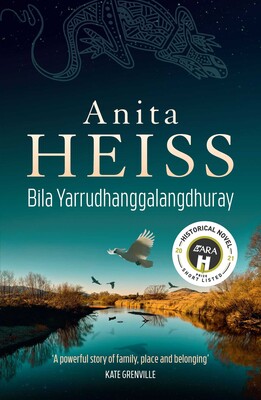
Fay and I are both readers and are constantly swapping books and recommending reads. I’ve just started reading Bila Yarrudhanggalangdhuray (River of Dreams) by Anita Heiss. Before that, I read Still Life by Sarah Winman. That is a beautiful book.
Fay
I’m a bit of a bookworm and devour as many books as I can. Both Sue and I swap books. I’m into any of Sarah J Maas books.
How can your readers contact you?
Sue
Readers can contact us via my website. The Contact Page has a form you can fill in. If you have a question just for Aunty Fay, I will forward it to her.
Thank you very much for speaking with such generosity about Sharing and your Our Place series, Aunty Fay and Sue. You are creating a beautiful and important legacy.
Thanks for having us both, Joy.
My review of Family & Respect at PaperbarkWords blog

2 thoughts on “Sharing by Aunty Fay Muir & Sue Lawson, illustrated by Leanne Mulgo Watson”